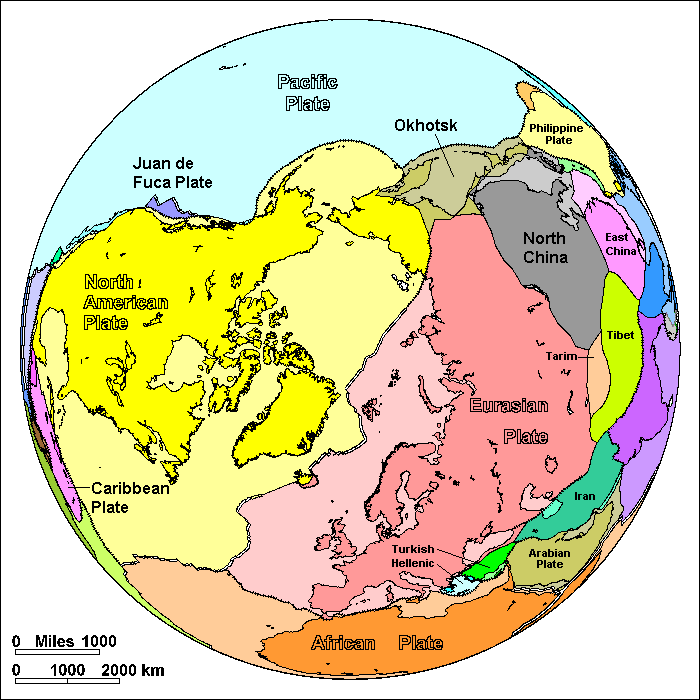The Arctic Ocean Sea Floor
Steven Dutch, Professor Emeritus, Natural and Applied Sciences, University of Wisconsin - Green Bay
Plates grow by pulling apart at the mid-ocean ridges and sinking back into the earth's interior at the tranches, mostly around the rim of the Pacific. As plates grow, they create strips of progressively older crust on either side of the ridge. We can determine the age of the ocean floor by drilling into it an retrieving samples, but mostly because newly formed crust is slightly magnetized by the earth's magnetic field, and we can compare the magnetism of the sea floor with the history of changes in the earth's magnetic field. North America began to separate from Africa about 180 million years ago.
The ocean floors show a remarkable degree of regularity. The crest of the mid-ocean ridges is at an average depth of 2700 meters, and the 3000 meter contour on the map reveals most of the crest. As newly formed ocean crust cools, it becomes denser and sinks, until it finally sinks to an average depth of 5500 meters. The broad deep areas about 5000-6000 meters below sea level are called abyssal plains and are the flattest areas on Earth. The very deepest parts of the ocean, up to 11 kilometers deep, make up a very tiny part of the sea floor. They are not out in the middle, like one might expect in a bowl. Instead they are long, narrow trenches close to a continent or island chain. The trenches mark convergent plate boundaries where oceanic crust sinks back into the earth's interior.
The earth has two kinds of crust. The continents are mostly made of thick granite. When continents pull apart, the gap is filled by thin crust made of basalt. In plate tectonics, a continent is any piece of continental crust surrounded by oceanic crust or plate boundaries. Greenland is a continent. When North America and Europe began to pull apart about 90 million years ago, Greenland originally moved as part of Europe for about 30 million years. Then the crust broke on the east side of Greenland, leaving it a separate plate for about 30 million years before it finally attached to the North American Plate.
On the colored diagrams, land is brown, and submerged continental crust is tan. The bluish gray area, labeled Submarine Volcanic Plateau, includes large areas of sea floor where thick accumulations of lava flows built up. This color also indicates areas where the exact age of the sea floor is uncertain.
The Arctic Ocean is just the northern extension of the Atlantic. A small piece of crust that separated from Europe is completely submerged and runs across the Arctic Ocean from northernmost Canada to Russia. This strip of crust is called the Lomonosov Ridge. In 2001 Russia claimed that it was an extension of Russia's sea bed and in 2007 an expedition deposited a Russian flag on the ridge at the North Pole. Canada and Denmark (which administers Greenland) also are exploring the ridge with possible intentions of claiming portions of it. The Western half of the Arctic Ocean probably formed when a piece of northeastern Siberia broke away.
Iceland is not continental crust at all. There is a long-lived source of magma called a hot spot beneath Iceland. Iceland is made up entirely of volcanic rocks and is really an exposed part of the Mid-Atlantic Ridge. Notice the broad sill running through Iceland connecting Greenland and Scotland. There is a source of magma under Iceland, called a hot spot, that erupts much more lava than the average mid-ocean ridge. As the North American and Eurasian Plates have pulled apart, the hot spot has left a track showing the motion of the plates. Volcanic rocks from the very earliest opening of the Atlantic are exposed in Greenland and some of the islands off Scotland.

Possible Coloring

Labeled Features
In addition to the large plates, significant small plates are labeled. Very small plates are not labeled.

Return to Geology Coloring Book Index
Return to Professor Dutch's Home Page
Created 10 August 2009, Last Update 15 January 2020